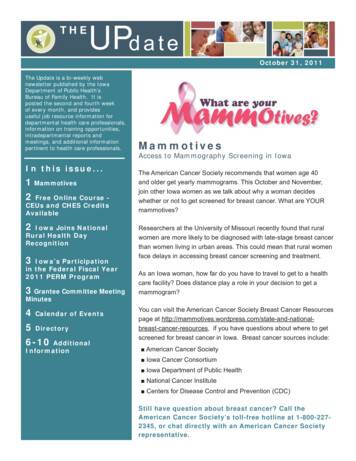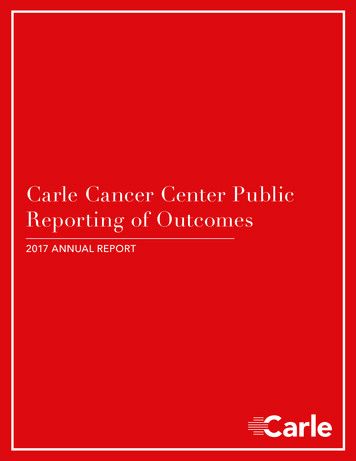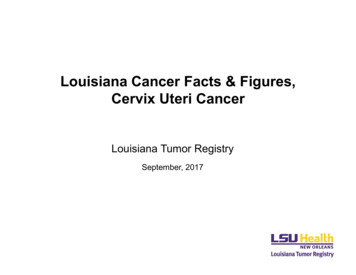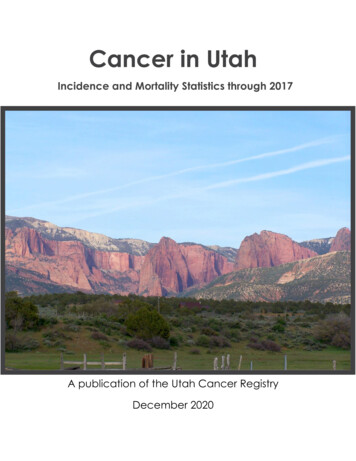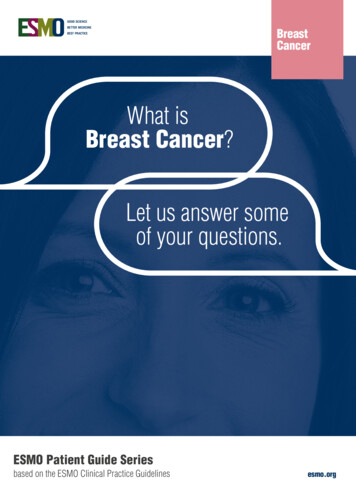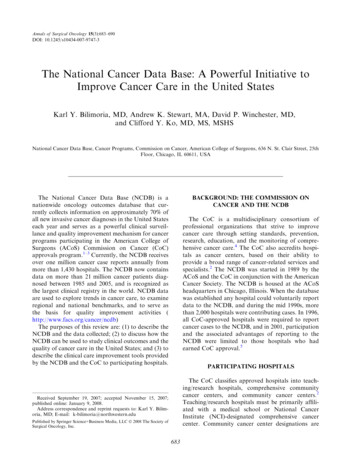
Transcription
Annals of Surgical Oncology 15(3):683–690DOI: 10.1245/s10434-007-9747-3The National Cancer Data Base: A Powerful Initiative toImprove Cancer Care in the United StatesKarl Y. Bilimoria, MD, Andrew K. Stewart, MA, David P. Winchester, MD,and Clifford Y. Ko, MD, MS, MSHSNational Cancer Data Base, Cancer Programs, Commission on Cancer, American College of Surgeons, 636 N. St. Clair Street, 25thFloor, Chicago, IL 60611, USAThe National Cancer Data Base (NCDB) is anationwide oncology outcomes database that currently collects information on approximately 70% ofall new invasive cancer diagnoses in the United Stateseach year and serves as a powerful clinical surveillance and quality improvement mechanism for cancerprograms participating in the American College ofSurgeons (ACoS) Commission on Cancer (CoC)approvals program.1–3 Currently, the NCDB receivesover one million cancer case reports annually frommore than 1,430 hospitals. The NCDB now containsdata on more than 21 million cancer patients diagnosed between 1985 and 2005, and is recognized asthe largest clinical registry in the world. NCDB dataare used to explore trends in cancer care, to examineregional and national benchmarks, and to serve asthe basis for quality improvement activities (http://www.facs.org/cancer/ncdb)The purposes of this review are: (1) to describe theNCDB and the data collected; (2) to discuss how theNCDB can be used to study clinical outcomes and thequality of cancer care in the United States; and (3) todescribe the clinical care improvement tools providedby the NCDB and the CoC to participating hospitals.BACKGROUND: THE COMMISSION ONCANCER AND THE NCDBThe CoC is a multidisciplinary consortium ofprofessional organizations that strive to improvecancer care through setting standards, prevention,research, education, and the monitoring of comprehensive cancer care.4 The CoC also accredits hospitals as cancer centers, based on their ability toprovide a broad range of cancer-related services andspecialists.2 The NCDB was started in 1989 by theACoS and the CoC in conjunction with the AmericanCancer Society. The NCDB is housed at the ACoSheadquarters in Chicago, Illinois. When the databasewas established any hospital could voluntarily reportdata to the NCDB, and during the mid 1990s, morethan 2,000 hospitals were contributing cases. In 1996,all CoC-approved hospitals were required to reportcancer cases to the NCDB, and in 2001, participationand the associated advantages of reporting to theNCDB were limited to those hospitals who hadearned CoC approval.5PARTICIPATING HOSPITALSThe CoC classifies approved hospitals into teaching/research hospitals, comprehensive communitycancer centers, and community cancer centers.2Teaching/research hospitals must be primarily affiliated with a medical school or National CancerInstitute (NCI)-designated comprehensive cancercenter. Community cancer center designations areReceived September 19, 2007; accepted November 15, 2007;published online: January 9, 2008.Address correspondence and reprint requests to: Karl Y. Bilimoria, MD; E-mail: k-bilimoria@northwestern.eduPublished by Springer Science Business Media, LLC Ó 2008 The Society ofSurgical Oncology, Inc.683
684K. Y. BILIMORIA ET hHospitalsComprehensiveCommunity CancerCenters% of NCDB HospitalsCommunity CancerCenters% of Cases Contributedbased on a combination of annual case volume andthe ability to provide a wide range of cancer-specificpersonnel and services. Of the 1,430 hospitals thatreport to the NCDB, approximately 20% are classified as teaching/research hospitals, 39% are comprehensive community cancer centers, 35% arecommunity cancer centers, and 6% are other cancercenters that include Veterans Health Administration(VA) hospitals (Fig. 1).Reporting hospitals are located in 49 US states andalso Puerto Rico. The cancer programs that report tothe NCDB include 19 of 20 adult National Comprehensive Cancer Network (NCCN) hospitals, 33 of37 NCI-designated cancer centers, and 69 of 121major inpatient VA hospitals. Some hospitals mayelect not to gain CoC approval and thus not contribute data to the NCDB, but the reasons for this areunclear. The 1,430 hospitals that have approvedcancer programs and report data to the NCDB account for approximately one third of the inpatienthospitals in the United States. While the NCDB doescollect the majority of incident cases in the UnitedStates, a hospital selection bias may exist as onlyCoC-approved hospitals contribute data to theNCDB.HOW CASES ARE REPORTEDIn 1973 federal legislation made invasive cancer areportable disease, and in 1992 federal legislationfurther mandated that all cancer cases be reported tostate cancer registries.6 The CoC requires its approved programs to abstract and follow all malignantAnn. Surg. Oncol. Vol. 15, No. 3, 2008OtherFIG. 1. Percentage distribution ofthe type of hospitals that report tothe NCDB and the percentage ofcases contributed by each hospitalto the NCDB for 2005. NCDB,National Cancer Data Base.tumors diagnosed and/or initially treated at the hospital.7 Annually, CoC-approved hospitals report overone million cancer cases to the NCDB. Approximately 940,000 cases are new invasive cancer diagnoses and account for about 70% of all new cancerdiagnoses in the United States, based on annualincidence estimates from the American Cancer Society (Table 1).8 In addition, the NCDB takes receiptof over 50,000 in situ cancers and 18,000 benign andborderline brain and central nervous system tumors.Patients diagnosed and treated in a physicianÕs officesetting, those who undergo consultation to confirm adiagnosis or formulate a treatment plan, and casesreviewed by pathology, but who never enter thehospital for any aspect of their care, are not reportedto the NCDB.Data reporting to the NCDB is highly standardized and similar to other state health departmentsand federal cancer registry data systems, includingthe NCIÕs Surveillance Epidemiology and End Results (SEER) program and the Centers for DiseaseControlÕs National Program of Cancer Registries(NPCR).9,10 Data reported from CoC-approvedhospitals are abstracted from patient charts byCertified Tumor Registrars (CTR) who undergotraining specific to cancer registry operations.11 Inrecent years, the training and certification requirements for CTRs have increased significantly, focusing on many of the nuances of cancer care. If datapoints are missing, registrars can query the treatingphysicians to obtain the necessary data to completethe record.All data submitted to the NCDB undergo a batteryof data integrity checks.12 The rigor of these data
685THE NATIONAL CANCER DATA BASETABLE 1. Proportion of invasive cancers in the United States reported to the NCDB in 2005 by organ siteCancer SiteAnusBladder2Bones and jointsBreastCervixColonEsophagusGallbladder and other biliaryKidney, renal pelvis, ureterLarynxLeukemiaLiver and intrahepatic bile ductsLung and bronchusLymphomaMelanomaOral cavity and pharynxOther sitesOvaryPancreasProstateRectumSmall intestineSoft tissueStomachTestisThyroidUterusTOTALNumber of invasivemalignancies reportedto the NCDBEstimated number ofannual cancer cases inthe United States1Proportion of invasivemalignancies reportedto the %63.5%71.5%92.1%74.8%68.6%Estimated number of invasive malignancies in the United States for 2005 based American Cancer Society estimates.63 The AmericanCancer Society has since revised their estimation methodology by basing their calculations on data from state cancer registries rather than onSEER regions. Estimates of cancer incidence have increased with this new methodology.2American Cancer Society estimates for bladder cancer include in situ disease.Note: The NCDB requires reporting of all in situ cancers for most cancer sites; however, these are not included in the table above. For 2005diagnoses, more than 50,000 in situ malignancies were reported to the NCDB. The NCDB also receives benign, as well as malignant, braintumors.1quality-assurance measures was increased significantly for the diagnosis year 2002 and expandedfurther for 2005 diagnoses. Case records that fail tomeet a standardized set of requirements are identifiedand returned to the hospital. Internal studies comparing the quality of data reporting from largeteaching/research hospitals and small communitycenters revealed no distinct differences in the completeness or accuracy of reported data.13Each year, the NCDB undergoes extensive internalquality monitoring and validity reviews. Aggregatedata are examined and verified in advance of the release of annual reports created for each cancer site,and the release of data for analytic purposes.14 Inaddition to these extensive automated electronicdata-quality checks, site surveyors from the CoCevaluate each hospitalÕs data and data-collectionprocesses once every three years, to ensure that highquality case information is being reported to theNCDB in an accurate and timely fashion. The NCDBhas also undergone multiple data-quality reviews.15–18Once diagnosed and/or treated at a hospital with aCoC-approved cancer program, the patient will befollowed by the hospital registrar and the case will bereported to the NCDB regardless of whether thepatient receives part of their care at a non-CoChospital. For example, a patient is diagnosed with amalignancy at hospital A which does not report tothe NCDB, undergoes surgery at hospital B whichreports to the NCDB, and then returns to hospital Afor adjuvant therapy. The CoC requires that thecancer registry at hospital B record the informationregarding diagnosis from hospital A and enter followup data from hospital A regarding subsequent treatment, recurrence, and survival (active surveillance). Ifboth hospitals were CoC approved, two case recordsfor the same patient would be reported to the NCDB,termed a ,clinical duplicate.Õ These duplicate cases areidentified using a computer algorithm, and the caseAnn. Surg. Oncol. Vol. 15, No. 3, 2008
686K. Y. BILIMORIA ET AL.record containing the most complete data is retainedin the analytic dataset.DATA ITEMS COLLECTEDThe NCDB collects data on patient factors, tumorcharacteristics, staging details, surgical and adjuvanttreatments, and outcomes, using nationally standardized coding guidelines.19 All CoC- approvedhospitals submitting data to the NCDB are requiredto use the Facility Oncology Registry Data Standards(FORDS) manual to guide abstracting and coding.7Additional guidelines for coding histopathologicalcharacteristics and stage of disease are established bythe World Health Organization (WHO) in its International Classification of Disease for Oncology(ICD-O) and the American Joint Committee onCancer (AJCC), respectively.20,21Tumor characteristics include size, the presenceand location of nodal and distant metastases, numberof nodes positive and examined, grade, margin status,and both clinical and pathological staging information. Clinical stage is a pretreatment assessment thatis recorded prior to surgery, and if the patientundergoes resection, a pathological stage is recordedseparately. Beginning with cases diagnosed in 2004,the NCDB started collecting Collaborative Stagedata elements, in addition to physician-recordedAJCC clinical and pathological tumor–node–metastasis (TNM) elements and overall stage. For thepurpose of assessing comorbidity, the InternationalClassification of Disease, 9th Edition (ICD-9-CM),secondary diagnosis codes, excluding cancer diagnoses and post-operative complications, are recordedfor each patient.The NCDB also collects a wide range of dataregarding surgical treatment and adjuvant therapy,including radiation, chemotherapy, hormone therapy, and other systemic treatments. Patients are alsofollowed to assess outcomes including readmissionwithin 30 days, recurrence, and survival. CoC-approved hospitals are expected to provide follow-upon at least 90% of all known living patients annually.Through linkage to tertiary data sources, areabased socioeconomic status and estimates of traveldistance/time to the reporting hospital can be obtained based on each patientÕs home zip code at thetime of diagnosis. In addition, hospital type andstructural characteristics can be determined throughlinkage with the CoCÕs facility information profilesystem (FIPS) file of self-reported hospital structuralfeatures, resources, and services related to oncology.4Ann. Surg. Oncol. Vol. 15, No. 3, 2008DATA CONFIDENTIALITYThe ACoS and the NCDB take great care to protect patient and hospital anonymity. The AmericanCollege of Surgeons has a business associate agreement with each of its CoC-approved hospitals thatprohibits the CoC from revealing hospital-specificinformation. Data reported to the NCDB are retrospective in nature. No direct patient identifiers arecollected. Analyses are reported only at the aggregatelevel to assist hospital cancer programs with qualityassurance and improvement. Reported results are incompliance with the privacy requirements of theHealth Insurance Portability and Accountability Act(HIPAA).22CLINICAL OUTCOMES STUDIESThe NCDB offers a large, nationally applicablesample to examine oncology practice patterns andoutcomes in the United States. Single institutionsstudies are typically from large centers that focus onparticular malignancies. With information from awide range of hospitals in diverse geographic locations, a better understanding of the variability in careacross the country can be analyzed, and, in particular, smaller, non-specialty hospitals can be examinedin order to compare differences by hospital type andvolume of patients. This is particularly importantsince the majority of cancer patients in the UnitedStates are not treated at high-volume, specializedcenters.Initially, the large number of patients available foranalysis through the NCDB resulted in a considerable body of descriptive literature on the clinical andepidemiologic characteristics of common cancers inthe United States.23 Subsequent studies have beenmore hypothesis driven and have addressed a broadrange of cancers and oncological issues. Severalstudies have used the NCDB to examine surgical andadjuvant therapy treatment trends and utilization.24–32 The large sample size offered by the NCDBallows studies of rare cancers (i.e., pancreatic neuroendocrine tumors, metaplastic breast cancer, andmelanoma in children)33–38 and subset analyses (i.e.,stage I pancreatic cancer patients undergoing resection, 1–2 cm papillary thyroid cancers, T3N0 coloncancer patients)27,30,39–42 with sufficient statisticalpower to make reasonable inferences. As AJCCstaging information is collected, numerous reportshave validated staging systems, and the AJCC hasrelied heavily on the NCDB to provide data for the
687THE NATIONAL CANCER DATA BASECancer Staging Manual and to guide staging-systemmodifications.21,42–46 Furthermore, studies usingNCDB data have addressed important clinical questions in areas where clinical trials may be challenging(i.e., local excision of rectal tumors, and extent ofsurgery for papillary thyroid cancer).27,47The broad range of hospital types reporting to theNCDB have also facilitated an array of health services research. The NCDB has been used to comparedifferences in treatment and outcome by hospital typeand volume of patients.25,39,48–50 Data from theNCDB have also been used to examine concordancewith established quality measures and standards ofclinical care.26,30,48,51 Multiple studies have alsoexamined cancer care for minorities and disadvantaged populations,52–54 and a recent article examinedhow clinical trials could be developed to specificallytarget minority populations.55 Statistical methodology pertaining to outcomes research has also beenexamined for multiple cancer sites.56 In addition, theNCDB can be used to obtain details beyond thosetypically collected, by requiring cancer registrars toascertain additional data points on a specific cohortof patients.27,50,51,57Although there are limitations associated with theuse of cancer registry data, appropriate, hypothesisdriven questions can be effectively investigated.58Administrative datasets are based on data withfinancial motivations, such as claims or reimbursement, whereas cancer registries are designed andcollect data with the intent of studying cancer epidemiology, treatment trends and utilization, outcomes, and the quality of cancer care. In addition,cautious investigations regarding the efficacy oftreatments can also be examined.27,59 Results fromthese studies are useful and important in order togenerate hypotheses for future prospective studiesand clinical trials.QUALITY IMPROVEMENTAlthough the NCDB is a tremendous repository ofoncologic data, perhaps the most important aspect isits ability to benchmark hospitals, and feed information back to the public and to participating hospitals. The NCDB offers public benchmark reportsfor the eleven most commonly diagnosed solid-organtumors in the United States.14 These reports currentlyprovide data on more than 5.9 million patients,allowing users to define queries based on patientgender, age, ethnicity, histology, stage, first-coursetherapy, type of surgical resection, hospital type, andgeographic location. The NCDB also offers five-yearsurvival reports stratified by AJCC staging.60In early 2007, the National Quality Forum (NQF)endorsed five quality measures developed in a jointeffort between the ACoS, the National Comprehensive Cancer Network (NCCN), and the AmericanSociety of Clinical Oncology (ASCO).61,62 Four ofthese measures focus on adjuvant therapy for breastand colorectal cancer, and one measure concerns theresection and pathological examination of 12 or moreregional lymph nodes for colon cancer. Hospitalswith CoC-approved cancer programs reporting to theNCDB are evaluated and benchmarked according totheir performance on these measures. Hospitals canexamine their performance on each measure in comparison to the other 1,430 CoC hospitals, allowingonly the reporting hospital to see where they rank incomparison to the rest of the state, region, or country(Fig. 2). Moreover, this data feedback mechanismallows hospitals to evaluate deficient records, to ensure the accuracy and completeness of their data, andmake corrections and additions as needed.These quality-of-care reports are intended to provide hospitals with the ability to measure and compare standards of cancer care at their facility to thatof a large number of hospitals across the country,without any associated accountability. Over the nextyear, the NCDB will be developing and incorporatingadditional quality measures for multiple cancers,including common (i.e., lung) and complex (i.e.,pancreas) malignancies.FUTURE DIRECTIONSThe power of the NCDB clearly rests in its abilityto receive data, analyze it, and send actionableinformation back to hospitals for the purposes ofquality improvement. These quality improvementactivities will play a significant role in the future forthe NCDB. In addition to the breast and colorectalinitiatives, quality measures must be developed forother cancer sites. These measures should not be usedfor accountability, but rather only to provide information to hospitals with the aim of improving patientcare and outcomes. In the future, federal regulatoryagencies, payers, purchasers, and consumers maylook to data from cancer registries to assess surgicalquality, determine reimbursement levels, and judgeproviders on the basis of process measures and patient outcomes.The NCDB will soon have a de-identified datasetavailable to investigators at CoC-approved hospitals.Ann. Surg. Oncol. Vol. 15, No. 3, 2008
688K. Y. BILIMORIA ET AL.FIG. 2. Sample benchmark reportcomparing hospitals on the administration/consideration of adjuvantchemotherapy for stage III coloncancer. Note that only the reporting hospital (arrow) can see theirindividual performance. Results areblinded for all other hospitals. Thex-axis represents 110 different Commission on Cancer (CoC)-approved hospitals.This file will provide the opportunity to examine alarge dataset containing a number of data items thatare not available through other cancer registriesincluding surgical margin status, systemic therapy(chemotherapy and hormonal therapy), detailedradiation treatment data, and clinical and pathological AJCC staging.ACKNOWLEDGEMENTSThe authors would like to recognize the staff of theNational Cancer Data Base: James M. Banasiak, E.Greer Gay, Kathy Mallin, Bryan Palis, Florin Petrescu, Jerri Linn Phillips, and Kimberly R. Porter.REFERENCESCONCLUSIONSThe NCDB is a large, powerful database providing multiple opportunities for clinical studies andquality-improvement endeavors. Importantly, theNCDB can be used to benchmark hospitals onperformance measures and serve as an impetus forquality improvement initiatives at the hospital level.Cancer registration activities are expensive for hospitals, but the benefits are clearly demonstrated bythe NCDBÕs extensive efforts to feed importantinformation back to participating institutions. TheNCDB is the only cancer registry that providesfeedback data to hospitals in such a manner. It isthe responsibility of surgeons, and their colleaguesin other oncologic specialties, to work collectively,and with their hospitalÕs cancer registrars, to continuously review and improve the accuracy, completeness and quality of the hospitalÕs cancerregistry data, and thus the quality of the data reported to the NCDB. The NCDB is a valuable toolto improve the quality of cancer care in the UnitedStates.Ann. Surg. Oncol. Vol. 15, No. 3, 20081. National Cancer Data Base. http://www.facs.org/cancer/ncdb/index.html. Cited 15 May 2007.2. Commission on Cancer: Approvals Categories. http://www.facs.org/cancer/coc/categories.html. Cited 16 July 2007.3. Winchester DP, Stewart AK, Bura C, et al. The NationalCancer Data Base: A clinical surveillance and qualityimprovement tool. J Surg Oncol 2004; 85:1–3.4. Commission on Cancer.http://www.facs.org/cancer. Cited 15July 2007.5. Commission on Cancer. Cancer Program l. Cited 1 July 2007.6. Cancer Registries Amendment Act, Public Law 102–515.Congressional Record 1992; 138, 106 STAT 3372–7.7. Facility Oncology Registry Data Standards. Chicago: Commission on Cancer; 2004.8. Jemal A, Murray T, Ward E, et al. Cancer statistics, 2005. CACancer J Clin 2005; 55:10–30.9. National Cancer Institute: SEER Surveillance Epidemiologyand End Results. http://seer.cancer.gov/. Cited 26 January 2007.10. National Program of Cancer Registries, Cancer SurveillanceSystem. http://www.cdc.gov/cancer/npcr/training/css.htm. Cited 11 August 2007.11. National Cancer Registrars Association: Certified ertification/index.htm. Cited 12 July 2007.12. Centers of Disease Control and Prevention: National Programof Cancer Registries, EDITS. http://www.cdc.gov/cancer/npcr/tools/edits/. Cited 1 July 2007.13. A. K. Stewart, E. G. Gay, L. Patel-Parekh, et al. Providerfeedback improves reporting on quality measures: National
THE NATIONAL CANCER DATA 9.30.31.32.33.34.profile reports for adjuvant chemotherapy for stage III coloncancer. Presented at the American Society of Clincal OncologyAnnual Meeting, Chicago, 2007.NCDB Public Benchmark Reports. http://www.facs.org/ncdbbenchmarks8.cfm. Cited 1 July 2007.Sylvester M, Blankenship C, Carter A, et al. Quality control:The American College of Surgeons Commission on CancerStandards, National Cancer Data Base, and Cancer LiasonProgram. J Reg Mgmt 2001; 28:68–74.Eberle C, Phillips J, Tary P, et al. Quality management in theNational Cancer Data Base: A re-abstracting study of theMidwest region. J Reg Mgmt 1997; 24:93–7.Fremgen A, Jessup J, Menck HR. Hospital use of NCDB datato assess quality of cancer patient care. J Reg Mgmt 1995;22:69–71.Mulnar K, Phillips J, Fritz A, et al. Quality of oncology data:Findings from the Commission on Cancer PCE study. J RegMgmt 2001; 28:24–34.Standards for Cancer Registries. Data Standards and DataDictionary, 8th Ed., Version 10.1, Vol. II. Springfield, IL:North American Association of Central Cancer Registries;2003.International Classification of Disease for Oncology, 3rd ed.Geneva: World Health Organization; 2000.AJCC Cancer Staging Manual. 6th ed. Chicago, IL: Springer;2002.Health Insurance Portability and Accountability Act (HIPAA), 1996. Standards for Privacy of Individually IdentifiableHealth Information; Final Rule (45 CFR Parts 160 and 164).National Cancer Data Base: Bibliography. http://www.facs.org/cancer/ncdb/biblclin.html. Cited 12 July 2007.Bilimoria KY, Tomlinson JS, Merkow RP, et al. Clinicopathologic features and treatment trends of pancreatic neuroendocrine tumors: analysis of 9,821 patients. J GastrointestSurg 2007; 11:1460–9.Bilimoria KY, Bentrem DJ, Linn JG. Utilization of totalthyroidectomy for papillary thyroid cancer in the UnitedStates. Surgery 2007; 142(6):906–13.Jessup JM, Stewart A, Greene FL, et al. Adjuvant chemotherapy for stage III colon cancer: implications of race/ethnicity, age, and differentiation. J Am Med Assoc 2005;294:2703–11.You YN, Baxter NN, Stewart A, et al. Is the increasing rate oflocal excision for stage I rectal cancer in the United Statesjustified? A nationwide cohort study from the National CancerDatabase. Ann Surg 2007; 245:726–33.David KA, Milowsky MI, Ritchey J, et al. Low incidence ofperioperative chemotherapy for stage III bladder cancer 1998to 2003: A report from the National Cancer Data Base. J Urol2007; 178:451–4.Bilimoria KY, Bentrem DJ, Ko CY, et al. Multimodalitytherapy for pancreatic cancer in the U.S.: Utilization, outcomes, and the effect of hospital volume. Cancer 2007;110:1227–34.Kennedy T, Stewart AK, Bilimoria KY, et al. Treatmenttrends and factors associated with survival in T1aN0 andT1bN0 breast cancer patients. Ann Surg Oncol 2007; 14:2918–27.Hoffman HT, Porter K, Karnell LH, et al. Laryngeal cancer inthe United States: Changes in demographics, patterns of care,and survival. Laryngoscope 2006; 116:S1–13.Singletary SE, Patel-Parekh L, Bland KI. Treatment trends inearly-stage invasive lobular carcinoma: A report from theNational Cancer Data Base. Ann Surg 2005; 242:281–9.Bilimoria KY, Talamonti M, Tomlinson JS, et al. Prognosticscore predicting survival after resection of pancreatic neuroendocrine tumors: Analysis of 3,851 patients. Ann Surg 2007;in press.Pezzi CM, Patel-Parekh L, Cole K, et al. Characteristics andtreatment of metaplastic breast cancer: Analysis of 892 50.51.52.53.54.55.689from the National Cancer Data Base. Ann Surg Oncol 2007;14:166–73.Lange JR, Palis BE, Chang DC, et al. Melanoma in childrenand teenagers: an analysis of patients from the NationalCancer Data Base. J Clin Oncol 2007; 25:1363–8.Zhen W, Karnell LH, Hoffman HT, et al. The National CancerData Base report on squamous cell carcinoma of the base oftongue. Head Neck 2004; 26:660–74.Smith RB, Apostolakis LW, Karnell LH, et al. NationalCancer Data Base report on osteosarcoma of the head andneck. Cancer 2003; 98:1670–80.Lee JH, Barich F, Karnell LH, et al. National Cancer DataBase report on malignant paragangliomas of the head andneck. Cancer 2002; 94:730–7.Bilimoria KY, Bentrem DJ, Ko CY, et al. National failure tooperate on early stage pancreatic cancer. Ann Surg 2007;246:173–80.Bilimoria KY, Bentrem DJ, Ko CY, et al. Validation of the 6thedition AJCC Pancreatic Cancer Staging System: report fromthe National Cancer Database. Cancer 2007; 110:738–44.Swanson RS, Compton CC, Stewart AK, et al. The prognosisof T3N0 colon cancer is dependent on the number of lymphnodes examined. Ann Surg Oncol 2003; 10:65–71.Fong Y, Wagman L, Gonen M, et al. Evidence-based gallbladder cancer staging: Changing cancer staging by analysis ofdata from the National Cancer Database. Ann Surg 2006;243:767–71; discussion 771–4.Bilimoria K, Bentrem DJ, Merkow R, et al. Application of thepancreatic adenocarcinoma staging system to pancreatic neuroendocrine tumors. J Am Coll Surg 2007; in press.Bilimoria KY, Bentrem DJ, Ko CY, et al. Validation of the6(th) edition AJCC pancreatic cancer staging system: reportfrom the National Cancer Database. Cancer 2007; 110:738–44.Greene FL. TNM staging for malignancies of the digestivetract: 2003 changes and beyond. Semin Surg Oncol 2003;21:23–9.Greene FL, Stewart AK, Norton HJ. New tumor-nodemetastasis staging strategy for node-positive (stage III) rectalcancer: An analysis. J Clin Oncol 2004; 22:1778–84.Bilimoria KY, Bentrem DJ, Ko CY, et al. Extent of surgeryaffects survival for papillary thyroid cancer. Ann Surg 2007;246:375–384.Bilimoria K, Stewart A, Palis B, et al. Adequacy and importance of nodal examination for colon cancer in the elderly. JAm Coll Surg 2007.Bilimoria K, Talamonti MS, Ko C, et al. Effect of hospital typeand volume on lymph node evaluation for gastric and pancreatic cancer. Western Surgical Association Annual Meeting,Colorado Springs, Colorado, 2007.Reid-Lombardo KM, Gay G, Patel-Parekh L, et al. Treatmentof gastric adenocarcinoma may differ among hospital types inthe United States, a report from the National Cancer DataBase. J Gastrointest Surg 2007; 11:410–9; discussion 419–20.Malin JL, Kahn KL, Adams J, et al. Validity of cancer registrydata for measuring the quality of breast cancer care. J NatlCancer Inst 2002; 94:835–44.Halpern MT, Bian J, Ward EM, et al. Insurance status andstage of cancer at dia
Improve Cancer Care in the United States Karl Y. Bilimoria, MD, Andrew K. Stewart, MA, David P. Winchester, MD, . Institute (NCI)-designated comprehensive cancer center. Community cancer center designations are Received September 19, 2007; accepted November 15, 2007; . SEER regions. Estimates of cancer incidence have increased with this new .



